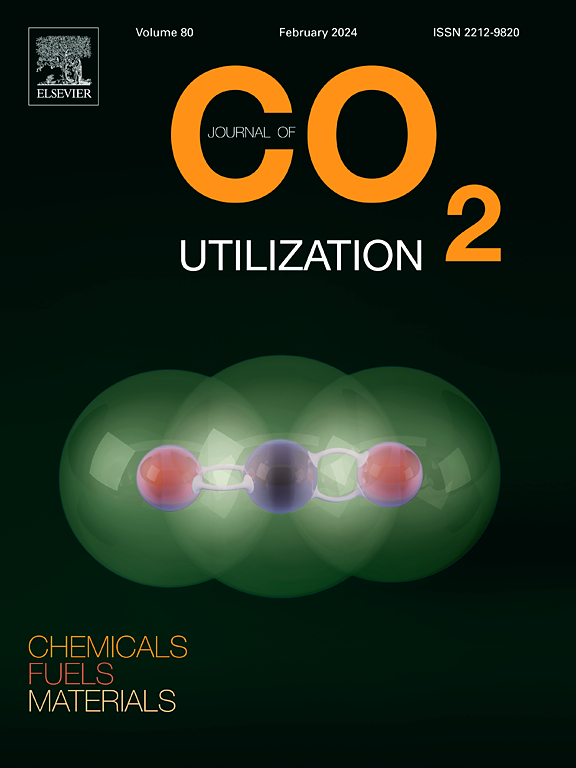氟化对1,2,3-三唑类离子液体中CO2捕获和活化的协同效应
IF 8.4
2区 工程技术
Q1 CHEMISTRY, MULTIDISCIPLINARY
引用次数: 0
摘要
二氧化碳的捕获和活化仍然是应对气候变化的关键挑战,需要具有卓越性能的创新材料。离子液体(ILs)由于其可调的物理化学性质、可忽略不计的蒸汽压以及针对与CO₂的特定分子相互作用进行定制的能力,已成为极有希望捕获CO₂的候选者。il的选择性氟化可以增强关键性能,如热稳定性和CO 2捕获能力,而不一定会损害材料稳定性并最大限度地减少潜在的环境和毒理学影响。在这项研究中,我们探讨了氟化对1,2,3-三唑基il的CO₂捕获和活化的协同作用。合成了两种三唑前体1-苄基-4-苯基- 1h -1,2,3-三唑(TR1)和1-{[3,5-二(三氟甲基)苯基]甲基}-4-苯基- 1h -1,2,3-三唑(TR2),并用于制备相应的离子液体:1-苄基-3-(全氟丁基)-4-苯基-1 h -1,2,3-三唑-3-碘化ium (IL-TR1)和1-(3,5-二(三氟甲基)苄基)-3-(全氟丁基)-4-苯基-1 h -1,2,3-三唑-3-碘化ium (IL-TR2)。综合结构和电子分析以及CO2吸附测量表明,tr1,2 -CO2和IL- tr1,2 -CO2加合物对IL形式的CO2吸附更有利,可提高高达56 %的CO2吸附性。这种增强表明,由于电子效应被结构变形引起的相对能量成本所补偿,il - tr1,2 - co2之间的相互作用更强。这种显著的增强是由于氟烷基引入的协同电子效应,它改善了IL和CO₂分子之间的相互作用。这些发现突出了加入氟烷基基团来调节三唑类il的性能的转化潜力。这项工作为下一代氟化il的合理设计铺平了道路,为可扩展和高效的CO 2捕获应用提供了一个有前途的平台。本文章由计算机程序翻译,如有差异,请以英文原文为准。
Synergistic effects of fluorination on CO2 capture and activation in 1,2,3-triazolium ionic liquids
The capture and activation of CO₂ remain a pivotal challenge in addressing climate change, requiring innovative materials with exceptional performance. Ionic liquids (ILs) have emerged as highly promising candidates for CO₂ capture due to their tuneable physicochemical properties, negligible vapor pressure, and ability to be tailored for specific molecular interactions with CO₂. Selective fluorination of ILs can enhance key properties, such as thermal stability and CO₂ capture capacity, without necessarily compromising material stability and minimizing potential environmental and toxicological impacts. In this study, we explored the synergistic effects of fluorination in 1,2,3-triazolium-based ILs on CO₂ capture and activation. Two triazole precursors, 1-benzyl-4-phenyl-1H-1,2,3-triazole (TR1) and 1-{[3,5-bis(trifluoromethyl)phenyl]methyl}-4-phenyl-1H-1,2,3-triazole (TR2), were synthesized and used to prepare the corresponding ionic liquids: 1-benzyl-3-(perfluorobutyl)-4-phenyl-1 H-1,2,3-triazol-3-ium iodide (IL-TR1) and 1-(3,5-bis(trifluoromethyl)benzyl)-3-(perfluorobutyl)-4-phenyl-1 H-1,2,3-triazol-3-ium iodide (IL-TR2). Comprehensive structural and electronic analyses, along with CO₂ sorption measurements, revealed that the CO2 up taking of TR1,2-CO2 and IL-TR1,2-CO2 adducts proved to be more favorable in the IL form, enhancing up to 56 % the CO2 adsorption. This enhancement suggests a stronger interaction in IL-TR1,2-CO2 owing to electronic effects compensated by relative energy cost due to structural deformations. This remarkable enhancement is attributed to the synergistic electronic effects introduced by the fluoroalkyl groups, which improve the interaction between the IL and CO₂ molecules. These findings highlight the transformative potential of incorporating fluoroalkyl groups to modulate the performance of triazolium ILs. This work paves the way for the rational design of next-generation fluorinated ILs, offering a promising platform for scalable and efficient CO₂ capture applications.
求助全文
通过发布文献求助,成功后即可免费获取论文全文。
去求助
来源期刊

Journal of CO2 Utilization
CHEMISTRY, MULTIDISCIPLINARY-ENGINEERING, CHEMICAL
CiteScore
13.90
自引率
10.40%
发文量
406
审稿时长
2.8 months
期刊介绍:
The Journal of CO2 Utilization offers a single, multi-disciplinary, scholarly platform for the exchange of novel research in the field of CO2 re-use for scientists and engineers in chemicals, fuels and materials.
The emphasis is on the dissemination of leading-edge research from basic science to the development of new processes, technologies and applications.
The Journal of CO2 Utilization publishes original peer-reviewed research papers, reviews, and short communications, including experimental and theoretical work, and analytical models and simulations.
 求助内容:
求助内容: 应助结果提醒方式:
应助结果提醒方式:


